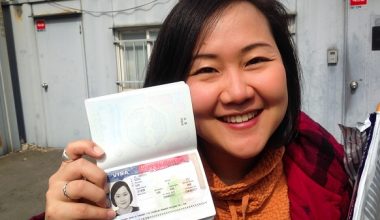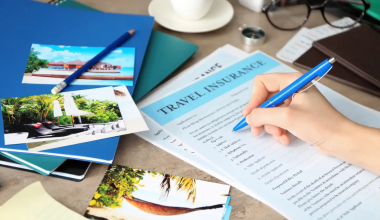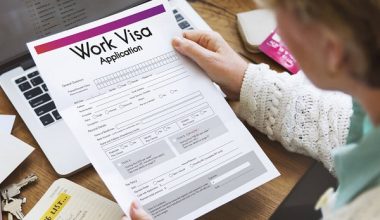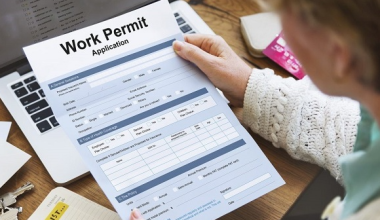Applying for U.S jobs with visa sponsorship is a significant step for individuals seeking employment opportunities in the land of opportunity. The United States is known for its thriving job market, diverse industries, and a vast range of career prospects, making it an attractive destination for professionals worldwide. However, for many foreign nationals, the process of securing a job in the U.S. can be challenging due to visa requirements and legal complexities.
In this post, we will explore the concept of applying for U.S. jobs with visa sponsorship, demystifying the essential aspects of this process and offering insight into how individuals can pursue their American dream.
For many non-U.S. citizens, obtaining a work visa is a pivotal part of the journey towards working in USA, work visa or employment-based visa, is a legal authorization that permits foreign nationals to work in the United States for a specific employer or within a particular field of expertise. It is critical to understand that not all jobs in the U.S. come with visa sponsorship, and not all visas are suitable for all job seekers. Therefore, the process of applying for jobs in the U.S. with visa sponsorship demands careful consideration, strategic planning, and a firm grasp of the U.S. immigration system.
This post also aims to provide you with a clear overview of the essential elements related to applying for U.S. jobs with visa sponsorship. We will discuss the different types of work visas available, the industries and companies that commonly offer visa sponsorship, and the key steps to navigate the application process.
Whether you are a recent graduate looking to kickstart your career, a seasoned professional seeking new challenges, or an entrepreneur with ambitions of establishing a business in the U.S., understanding the intricacies of applying for U.S. jobs with visa sponsorship is a crucial first step. So, let’s embark on this journey to unravel the possibilities and avenues for realizing your career aspirations in the United States.
Types of U.S Visa Sponsorship
There are several types of U.S. visa sponsorship, each designed for different purposes and categories of applicants. Here are some of the most common types of U.S. visa sponsorships:
1. Family Sponsorship:
- Immediate Relative Visas (IR): These are for close family members of U.S. citizens, including spouses, unmarried children under 21, and parents.
- Family Preference Visas (F): These are for more distant relatives of U.S. citizens, including adult children and siblings.
2. Employment-Based Sponsorship:
- H-1B Visa: Sponsored by U.S. employers for foreign workers in specialty occupations.
- L-1 Visa: For intracompany transferees, allowing employees of multinational companies to work in the U.S.
- O – Visa: For individuals with extraordinary abilities or achievements in fields like arts, sciences, athletics, or business.
- P Visa: For athletes, artists, and entertainers with international recognition.
- E Visa: For treaty traders and investors.
- R-1 Visa: For religious workers sponsored by religious organizations.
3. Diversity Visa (DV) Lottery:
The U.S. Diversity Visa Lottery, also known as the Green Card Lottery, is a program that provides a limited number of immigrant visas to individuals from countries with low rates of immigration to the United States.
4. Student Visa Sponsorship:
F-1 Visa: For international students seeking to study at U.S. academic institutions. The educational institution typically serves as the sponsor.
5. Exchange Visitor Program:
J-1 Visa: For individuals participating in exchange programs, including students, researchers, and cultural exchange participants. Sponsorship comes from designated exchange program sponsors.
6. Religious Worker Visa Sponsorship:
R-1 Visa: Religious organizations can sponsor foreign religious workers coming to the U.S. to perform religious duties.
7. Investor and Entrepreneur Visa:
EB-5 Visa: For immigrant investors who invest a specified amount of capital in a U.S. commercial enterprise, creating jobs for U.S. workers.
8. Asylum and Refugee Sponsorship:
Asylum seekers and refugees are sponsored through the U.S. government’s humanitarian programs. Individuals may be sponsored by various organizations that work with refugees and asylum seekers.
9. U Visa:
U Visas are available to crime victims who have suffered mental or physical abuse and are helpful to law enforcement investigations or prosecutions. Law enforcement agencies may sponsor U visa applicants.
10. Humanitarian Sponsorship:
Certain humanitarian categories, such as victims of trafficking (T visa) or victims of domestic violence (VAWA self-petition), may be sponsored for immigration benefits.
11. Special Visa Categories:
There are several special visa categories for specific purposes, including the S visa for informants, the K visa for fiancé(e)s of U.S. citizens, and more.
Visas To Apply For To Get U.S. Jobs With Visa Sponsorship
If you are interested in working in the United States and need visa sponsorship, there are several visa options to consider depending on your qualifications, the type of job you’re seeking, and your employer’s willingness to sponsor you. Here are some of the most common work-related visas that you can apply for to work in the U.S. with visa sponsorship:
1. H-1B Visa:
- This visa is for foreign professionals in specialty occupations, including fields like IT, engineering, healthcare, and more.
- Requires a job offer from a U.S. employer who will sponsor your H-1B visa.
- It is subject to an annual cap, and the application process typically begins in April for an October start date.
2. L-1 Visa:
- For intracompany transferees, allowing employees to work in the U.S. for a parent, subsidiary, affiliate, or branch office of their foreign employer.
- There are two subcategories: L-1A for managers and executives and L-1B for employees with specialized knowledge.
3. O-1 Visa:
- Reserved for individuals with extraordinary ability or achievement in their field, such as artists, scientists, athletes, and business professionals.
- Requires evidence of exceptional expertise and recognition in your industry.
4. TN Visa:
- Available to Canadian and Mexican citizens under the United States-Mexico-Canada Agreement (USMCA) for certain professional positions.
- Requires a job offer and specific qualifications based on the eligible profession.
5. E-3 Visa:
- Specifically for Australian citizens seeking employment in a specialty occupation in the United States.
- Requires a job offer and a Labor Condition Application (LCA) from the employer.
6. H-2B Visa:
- For temporary non-agricultural workers, typically in industries like hospitality, landscaping, and construction.
- Employers need to prove that there are not enough U.S. workers available for the job.
7. J-1 Visa:
- Intended for exchange visitors and includes various categories, such as interns, trainees, and professors.
- Employers may sponsor J-1 visa holders through designated exchange programs.
8. E-2 Visa:
- Available to nationals of countries with which the U.S. has a treaty of commerce and navigation.
- Requires investment in a U.S. business, making it more suitable for entrepreneurs and business owners.
9. H-3 Visa:
- For individuals coming to the U.S. to receive training that is not available in their home country.
- Typically sponsored by employers for training programs.
10. Green Card (Employment-Based):
- A permanent resident status that allows you to live and work in the U.S. indefinitely.
- Requires a job offer and a multi-step process, including labor certification and preference category determination.
Requirements To Apply For U.S. Jobs With Visa Sponsorship
Applying for jobs in the United States with visa sponsorship can be a complex process, and the specific requirements may vary depending on the type of visa you are seeking and the job you are applying for.
However, there are some general steps and requirements that typically apply to most employment-based visa applications. Here is an overview:
1. Identify the Appropriate Visa Type:
The first step is to determine the type of visa that is suitable for your situation. Some common employment-based visas include the H-1B, L-1, O-1, and EB visas. Each visa category has its own eligibility requirements.
2. Find a Job with Visa Sponsorship:
You will need to find a U.S. employer willing to sponsor your visa. This typically involves a job offer from a U.S. company.
3. Meet the Qualifications:
Ensure that you meet the qualifications and requirements for the specific visa category you are applying for. For example, H-1B visas are typically for individuals in specialty occupations that require at least a bachelor’s degree or equivalent.
4. Labor Condition Application (LCA):
For H-1B and E-3 visas, the employer must file a Labor Condition Application (LCA) with the U.S. Department of Labor. The LCA certifies that the employer will pay the prevailing wage and meet other labor-related requirements.
5. Submit a Visa Petition:
Your U.S. employer will file a visa petition on your behalf with U.S. Citizenship and Immigration Services (USCIS) or, in some cases, with the U.S. Department of State.
6. Wait for Approval:
The petition will be reviewed by USCIS or the Department of State. If approved, you will receive a Notice of Approval (I-797) or a similar document.
7. Apply for a Visa:
Once your petition is approved, you can apply for the actual visa at a U.S. consulate or embassy in your home country. This often involves an interview with a consular officer.
8. Attend the Visa Interview:
Attend the visa interview at the U.S. consulate or embassy. You may be asked to provide additional documentation to prove your eligibility.
9. Medical Examination and Background Checks:
You may need to undergo a medical examination and background checks as part of the visa application process.
10. Visa Issuance:
If your visa application is approved, you will be issued a visa that allows you to enter the United States for the specific job and employer mentioned in the petition.
11. Maintain Visa Status:
Once in the United States, it’s important to adhere to the terms and conditions of your visa, maintain legal status, and follow any specific requirements associated with your visa type.
How To Find U.S. Jobs With Full Visa Sponsorship
Finding a job in the United States with full visa sponsorship can be a challenging process, but it’s not impossible.
Here are steps you can follow to increase your chances of securing a job with visa sponsorship:
1. Determine Your Visa Eligibility:
Understand the different visa options available for working in the U.S., such as H-1B, L-1, J-1, and O-1 visas. Research which visa aligns with your qualifications and career goals.
2. Develop a Target List of Employers:
Identify companies that are known for hiring international candidates and offering visa sponsorship. Large corporations, tech companies, research institutions, and multinational companies are often more willing to sponsor visas.
3. Networking:
Building a strong professional network is crucial. Attend networking events, job fairs, and conferences. Utilize platforms like LinkedIn to connect with professionals in your industry.
4. Research Job Listings:
Use job search websites and company career pages to look for job postings that explicitly mention visa sponsorship or are open to hiring international candidates.
5. Customize Your Resume:
Tailor your resume to highlight your skills and experience that are relevant to the job you’re applying for. Emphasize your international background as an asset.
6. Prepare a Cover Letter:
Write a compelling cover letter that explains your qualifications, visa needs, and why you are the ideal candidate for the position. Clearly express your commitment to the company.
7. Apply for Jobs:
Submit your application materials for positions that match your qualifications and career goals. Follow the application instructions carefully.
8. Stay Informed About Visa Processes:
Keep up to date with changes in immigration laws and visa application processes. This will help you prepare for interviews and visa documentation requirements.
9. Interview Preparation:
Practice interview questions and anticipate visa-related questions. Be ready to explain your visa needs and why you are a valuable asset to the company.
10. Work with an Immigration Attorney:
Consider hiring an immigration attorney to assist with the visa application process. They can help ensure that your application is complete and in compliance with U.S. immigration laws.
11. Be Patient:
The process of finding a job with visa sponsorship can be time-consuming. Be patient, and consider gaining experience or skills in your home country while continuing your job search.
12. Leverage Educational Institutions:
If you are a student or recent graduate, some U.S. educational institutions have programs that facilitate visa sponsorship for international students. Explore Optional Practical Training (OPT) and Curricular Practical Training (CPT) opportunities.
13. Look for Remote or International Opportunities:
Some companies may be open to hiring you for remote work or international assignments before sponsoring your U.S. visa. This can be a stepping stone to securing a U.S. job.
How To Apply For U.S. Jobs With Visa Sponsorship
Applying for U.S. jobs with full visa sponsorship can be a challenging process, but it’s certainly possible if you meet the requirements of the job and the visa category you’re applying for.
Here’s a step-by-step guide on how to do it:
1. Determine the Appropriate Visa Category:
You need to identify the visa category that best suits your qualifications and the job you’re applying for. Common visa categories for employment with full sponsorship include H-1B (for specialized workers), L-1 (for intracompany transfers), and EB-2 or EB-3 (employment-based green cards). Ensure you meet the specific eligibility criteria for your chosen category.
2. Job Search:
Start your job search. Look for employers who are known to sponsor visas for foreign workers. Job search platforms like LinkedIn, Indeed, Glassdoor, and company websites are good places to start. You can also network with professionals in your field to identify potential employers.
3. Resume and Cover Letter:
Tailor your resume and cover letter to match the job requirements. Highlight your skills, qualifications, and any experience that makes you a strong candidate. Mention your need for visa sponsorship in your cover letter to clarify your status.
4. Apply for Jobs:
Apply for jobs that match your qualifications and indicate that they are open to sponsoring visas. Follow the application instructions on each job posting.
5. Prepare for Interviews:
If an employer shows interest, be prepared for interviews. Showcase your skills and cultural fit for the company. Make sure to discuss visa sponsorship openly during the interview process.
6. Receive Job Offer:
If you receive a job offer, make sure it includes a clear commitment to sponsoring your visa. Review the job offer letter carefully and seek legal advice if necessary.
7. Legal Assistance:
Consult with an immigration attorney or legal expert who specializes in U.S. immigration. They can guide you through the visa application process and ensure that all legal requirements are met.
8. Submit Visa Petition:
Your employer will typically initiate the visa sponsorship process by filing a petition with the U.S. Citizenship and Immigration Services (USCIS) on your behalf. They will need to provide necessary documentation and fees.
9. Attend Visa Interview:
If your visa category requires an interview (e.g., H-1B), attend the interview at the U.S. embassy or consulate in your home country.
10. Visa Approval:
Once your visa is approved, you can travel to the U.S. to start your job.
11. Compliance and Renewal:
Be sure to maintain visa compliance throughout your stay in the U.S. Work with your employer and legal counsel to ensure that your visa is renewed as needed.
Top Industries and Companies in USA for Visa Sponsorship
Visa sponsorship in the United States is commonly sought by foreign workers looking to move to the country for employment opportunities. The availability of visa sponsorship varies by industry and company.
Some industries and companies that have historically sponsored visas for foreign workers in the U.S. include:
1. Technology and IT:
- Amazon
- Microsoft
- Apple
- IBM
2. Finance and Banking:
- JPMorgan Chase
- Goldman Sachs
- Morgan Stanley
- Citibank
- Bank of America
3. Consulting:
- McKinsey & Company
- Boston Consulting Group (BCG)
- Deloitte
- PricewaterhouseCoopers (PwC)
- Ernst & Young (EY)
4. Healthcare:
- Mayo Clinic
- Cleveland Clinic
- Johns Hopkins Medicine
- Kaiser Permanente
- HCA Healthcare
5. Engineering:
- Boeing
- Lockheed Martin
- General Electric (GE)
- Intel
- Raytheon Technologies
6. Pharmaceuticals and Biotechnology:
- Pfizer
- Johnson & Johnson
- Amgen
- Gilead Sciences
- Genentech
7. Automotive:
- General Motors
- Ford
- Fiat Chrysler (now Stellantis)
- Tesla
- Honda
8. Aerospace:
- SpaceX
- Northrop Grumman
- Blue Origin
- Sierra Nevada Corporation
- Virgin Galactic
9. Consumer Goods:
- Procter & Gamble
- Coca-Cola
- Nestlé
- Unilever
- PepsiCo
10. Retail:
- Walmart
- Amazon
- The Home Depot
- Target
- Costco
Benefits of Getting a US Job with Visa Sponsorship
Obtaining a job in the United States with visa sponsorship can offer numerous benefits. Here are some of the advantages:
1. Work in the U.S.:
Visa sponsorship allows you to legally work and live in the United States. This is an opportunity to gain valuable work experience in a diverse and dynamic economy.
2. Access to Better Job Opportunities:
Many U.S. companies hire foreign workers to fill positions that require specialized skills or experience. Visa sponsorship can open doors to job opportunities that might not be available in your home country.
3. Career Advancement:
Working in the U.S. can provide you with access to a larger job market and more opportunities for career advancement. It can be a stepping stone to achieving your long-term career goals.
4. Higher Income:
Salaries for certain positions in the United States can be higher than those in other countries. This can lead to a better standard of living and increased financial stability.
5. Cultural Exchange:
Working in the U.S. offers the chance to immerse yourself in American culture and to interact with people from diverse backgrounds. This can be a personally enriching experience.
6. Networking:
The U.S. is home to many global companies and industries. By working in the U.S., you can build a strong professional network that can benefit your career in the long run.
7. Education Opportunities:
If you have family members or dependents, they may have access to quality education in the United States. Many U.S. schools and universities are highly regarded worldwide.
8. Immigration Pathway:
Some visa sponsorships can serve as a pathway to permanent residency (green card) in the U.S. This can be especially valuable for individuals looking to establish a long-term life in the country.
9. Skill Development:
Working in the U.S. can provide opportunities for skill development and training that can be valuable throughout your career.
10. Global Experience:
U.S. work experience can be highly regarded by employers in other countries. It can make you more competitive in the global job market.
Frequently Asked Questions
1. What is visa sponsorship for employment in the US?
Visa sponsorship for employment in the US is when a US employer agrees to sponsor a foreign worker for a work visa, typically the H-1B, L-1, or other relevant visa, allowing them to legally work in the United States.
2. Which visas are commonly sponsored by US employers for foreign workers?
The most common work visas sponsored by US employers include H-1B visas for skilled workers, L-1 visas for intracompany transfers, and E-3 visas for Australian nationals. Other visas may be applicable depending on the individual’s qualifications and the employer’s needs.
3. Who is eligible for visa sponsorship by a US employer?
Eligibility depends on the specific visa category and the qualifications of the foreign worker. Generally, eligible candidates are those with a job offer from a US employer and the necessary skills, education, and experience required for the position.
4. How can I find US jobs with visa sponsorship?
You can find US jobs with visa sponsorship by searching on job boards, company websites, or using specialized platforms and resources dedicated to connecting international job seekers with US employers willing to sponsor visas.
5. Can I apply for jobs in the US if I already have a work visa?
Yes, you can apply for jobs in the US if you already have a valid work visa. Employers may be more inclined to hire individuals with existing work authorization, as it simplifies the hiring process.
6. Do all US employers offer visa sponsorship?
No, not all US employers offer visa sponsorship. The availability of visa sponsorship varies from one company to another. Some companies are more willing to sponsor foreign workers, especially for certain specialized positions, while others may not offer this option.
7. How does the visa sponsorship process work?
The visa sponsorship process involves the US employer filing a petition with US Citizenship and Immigration Services (USCIS) on behalf of the foreign worker. The process may vary depending on the visa type, but it typically includes obtaining a Labor Condition Application (LCA), submitting the visa petition, and the worker attending an interview at a US embassy or consulate.
8. What is the duration of a work visa?
The duration of a work visa varies depending on the specific visa category and individual circumstances. H-1B visas, for example, are typically granted for up to three years, with the possibility of extensions. L-1 visas have different maximum durations, and other visa types also vary.
9. Can I change employers while on a work visa in the US?
It is possible to change employers while on a work visa, but the new employer must file a petition to transfer the visa sponsorship. The process for changing employers while on a visa can be complex and should be done in accordance with immigration regulations.
10. What should I do if my visa is about to expire?
If your work visa is about to expire, you should work with your employer and an immigration attorney to explore options for visa extension or renewal. It’s important to address visa expiration issues well in advance to avoid any legal complications.
Final Note
In conclusion, applying for US jobs with visa sponsorship is a crucial and often challenging step for individuals seeking to work in the United States. It requires a strategic approach that includes thorough research, the creation of a compelling application, and effective networking. Visa sponsorship, typically provided by employers, is a complex process that demands patience and an understanding of the various visa categories available.
To increase your chances of success, it is essential to be well-prepared, demonstrate your qualifications and skills clearly, and showcase how you can bring value to potential employers. Networking and reaching out to companies that actively sponsor visas can also open up valuable opportunities.
While the process can be daunting, it is essential to stay persistent, keep refining your application strategy, and remain adaptable to changes in immigration policies. The pursuit of US job opportunities with visa sponsorship can be a challenging journey, but with determination and the right approach, it can lead to fulfilling career prospects in the United States.
Remember that finding a job with full visa sponsorship can be competitive, so persistence and a targeted approach are essential. Building a strong professional network and continuously improving your skills will also increase your chances of securing employment in the U.S.
Please note that immigration laws and visa requirements can change, so it’s important to consult with an immigration attorney or check the U.S. Citizenship and Immigration Services (USCIS) website for the most up-to-date information and guidance on the specific visa category you are interested in.






